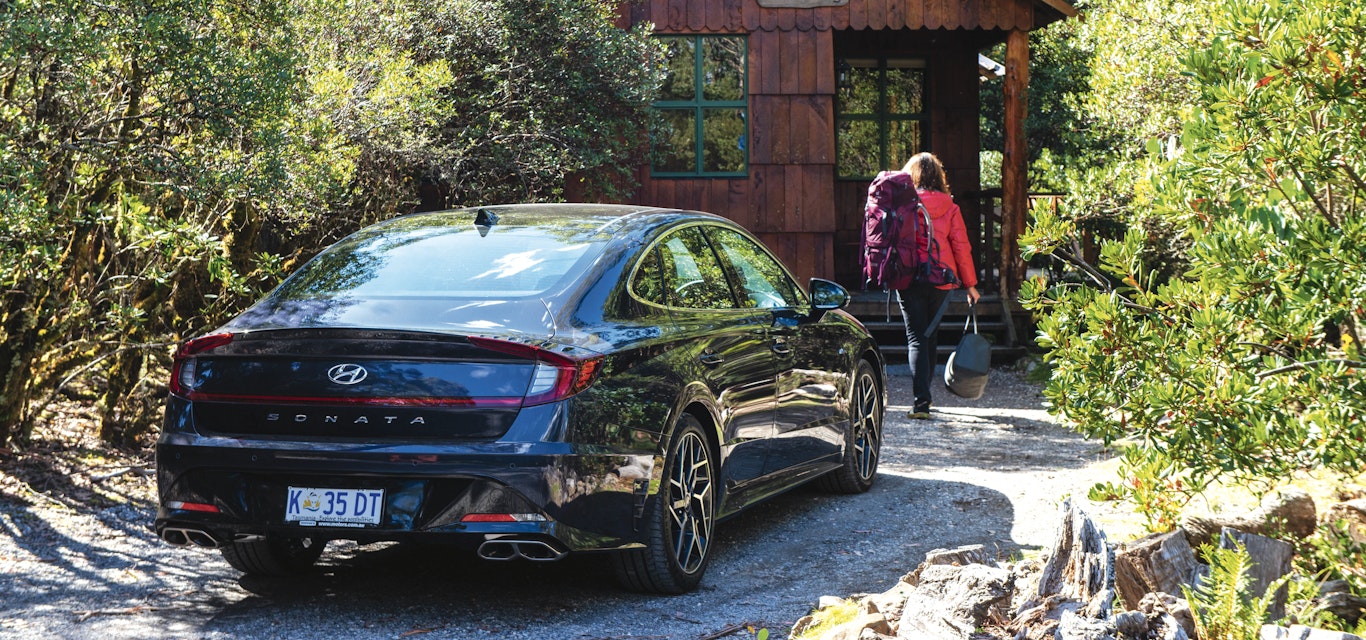Road test: Hyundai Sonata 2021 N Line
The Hyundai Sonata 2021 N Line is more than just a sleek sedan, it has serious power too, discovers Elspeth Callender on a drive to Cradle Mountain.
When I heard I’d be road testing a Hyundai Sonata I was transported back to a time of Duran Duran on cassette tape, Fizz Wizz and fluorescent socks. Since 1985, this unstylish little number has unexpectedly evolved into something both powerful and attractive. The Sonata has come a long way too.
Hyundai’s 8th-generation Sonata, built in Korea, was released to the Australian market in October 2021. The Launceston dealership sales consultant tells me it’s a vehicle people don’t necessarily come looking for but it always gets snapped up from the showroom.
I certainly wasn’t expecting dual twin exhaust pipes, an elaborate grill, huge sunroof, aero fins and those 19-inch alloys. Red-stitched seats are suede and leather, the steering wheel has a fourspoke design while dash and head-up displays are fully digital. Light architecture is super striking especially the singular linear taillight.
Credit: Chris Crerar
Being in Hyundai’s N Line range, this Sonata is characterised by specific design and performance-enhancing elements. All bells and whistles come standard except a black, red or white paintjob.
German-born Peter Schreyer, Hyundai Motor Group’s executive design advisor, haspreviously worked with Audi and Volkswagen. Since 2006, Schreyer has been responsible for the transformation of the brand and the Sonata’s identity.
From Cethana through Moina and beyond it's the most comfortable and fun driving experience I've ever had on this windy road.
We load the boot with gear and I punch Cradle Mountain into the touchscreen navigation system. It’s 140km west. Before I even reach the Bass Highway I’ve switched driver mode from normal to sport for a more responsive accelerator and to watch the dynamic display change with an entertaining flash.
This model is Hyundai’s most powerful front-wheel-drive sedan to date – hello high performance turbo engine. Torque comes on nice and early in the rev range and torque steer is minimal. The engine and exhaust have been so cleverly tuned my travel companion assumes it’s a 6-cylinder.
Heated front and rear seats and steering wheel make it a winner here in winter. There’s also front seat cooling. I find climate controls intuitive to use from the get-go.
A split-screen function allows me to simultaneously engage with both climate and the Bose sound system. Hyundai’s ambient sound options include Rainy Day, Lively Forest and Open Air Cafe, but I stick to my own tunes through Apple CarPlay. That function isn’t wireless, but there is a wireless smartphone charging pad.
Driving a sedan is making me nostalgic for an era in Australia when they were typical family vehicles, so I go for an 80s playlist. Turns out, so many songs from then are about cars.
In Deloraine, we beeline for Brush Rabbit coffees. In Sheffield, it’s venison and Guinness pies from Bossimi’s Bakehouse plus a hotdogshaped custard donut. After more dramatic peaks and some hydro retro around GowriePark, we stop briefly at Round Hill Coffee in Cethana.
Whenever I start the keyless ignition it reestablishes my pre-programed seat and mirror settings and reconnects to my phone. Most of its multitude of safety and driver assist features can be customised, including deactivation of the automatic door locking and that welcome sound. With headlights on auto, I’ll later discover, high beam assist flicks lights down and up when oncoming traffic is or isn’t detected.
The safety feature I most appreciate is my blind spot appearing on the dash when I’m indicating, courtesy of 360 cameras. This also means that, when parking, I can see the country town cobbled curbs and not scratch the rims.
Despite sporty appearances this Sonata isn’t impractical. It can tow up to 1400kg, is relatively wide, has good storage including a generous boot and the back seats fold forward. Rear windscreen and back windows have retractable sunshades.
Hyundai call the 8-speed transmission shiftby- wire because you press P, R,N and D to send electronic signals as opposed to the conventional gear lever and cogs. I have to look down to see what button I’m pressing but they’re laid out in such a way that you could easily learn to go by feel.
Gear changes are barely detectable. Paddle shifters on the steering wheel are for manual gear changing but I never feel the need in this vehicle. The steering isn’t super light but I like the control; it goes exactly where I put it.
From Cethana through Moina and beyond it’s the most comfortable and fun driving experience I’ve ever had on this windy road. A combination, I believe, of supportive seats, large brakes, passenger-friendly tuned suspension and a low profile. It handles hairpins beautifully, feels grippy and planted and has an efficient turning circle.
We’re staying at Highlanders Cabins in the woodfire-heated Currawong cottage and tomorrow will walk rainforest trails behind Cradle Mountain Lodge. Yet, at the Cradle Mt turnoff, I’m just not ready to stop so I take this fast car and keep on driving.
The specs
Pricing: $50,990 driveaway
Safety ANCAP rating: 5 stars
Engine type: Turbocharged 4-cylinder GDi
Engine capacity: 2.5 litres
Max. torque: 422Nm @ 1650–4000rpm
Max. power: 213kW @ 5800rpm
Body style: 4-door sedan
Transmission: Auto 8-speed dual clutch (wet)
Drive type: Front-wheeldrive
Seating: 5
Fuel consumption: 8.1L/100km (combined)
0-100 km/h: 8.2 seconds
